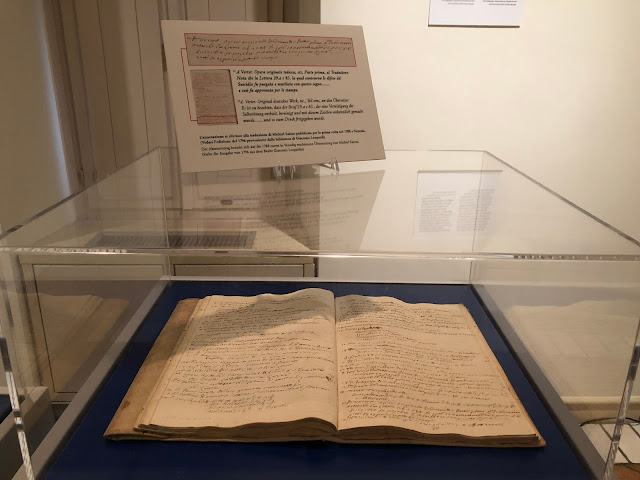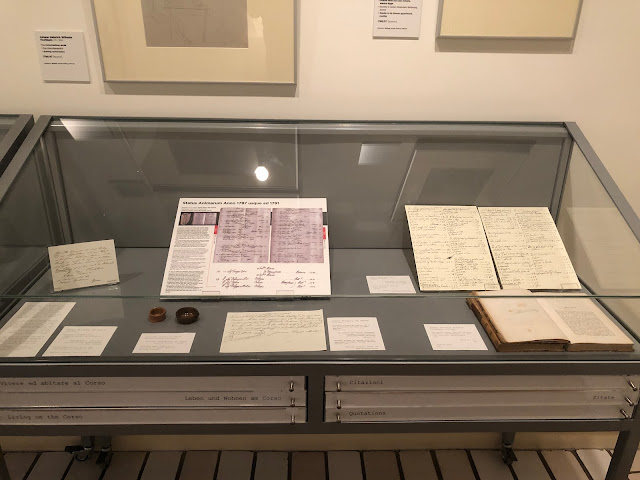【ローマ】ゲーテの家 イタリア紀行 Roma - Casa di Goethe and Italienische Reise
ローマのポポロ広場近くあるゲーテの家には、ゲーテの残した手紙やノートなどの数多くの資料が展示されている。
ゲーテは1774年、25歳の時に『若きウェルテルの悩み』を出版して、一躍有名になった。
その翌年にはワイマール公国のアウグスト公に招かれて、ワイマールに居を移した。その後、閣僚の一人にも任命されて、およそ10年間を忙しくワイマールの地で過ごした。
ゲーテは、若い頃に父親の意向でライプツィヒで法学の勉強をしており、行政家や政治家としての振る舞いもできる人物であったようだ。
また、ワイマールでは年上の人妻であったシュタイン夫人と不倫関係を続けていた。
Goethe's house near Piazza del Popolo in Rome displays many materials such as letters and notebooks left by Goethe.
Goethe became famous in 1774 when he published "The Sorrows of Young Wertel" at the age of 25.
The following year, he was invited by Prince August of the Principality of Weimar to move to Weimar. After that, he was appointed as one of the ministers and spent about 10 years busy in Weimar.
Goethe was studying law in Leipzig at the will of his father when he was young, and seems to have been able to act as an executive and politician.
He also continued to have an affair with his older wife, Mrs. Stein, in Weimar.
1786年、ゲーテは周囲の人々にほとんど何も告げずに、突然、憧れの地であるイタリアに向かって旅立った。10年間の様々なストレスが、ピークに達してしまったのだろうか。
そしてゲーテは、ヴィチェンツァ、ヴェローナ、ヴェネツィア、フェラーラ、ローマ、ナポリ、パレルモ、カターニャなどのイタリアの各地を、およそ1年半をかけて訪ね歩いた。
現在のせいぜい1週間や2週間の観光旅行と比べると、なんとゆったりとした時間が流れていたことだろう。
イタリア旅行中にゲーテは戯曲『エグムント』を完成させて、『ファウスト』の執筆を始めた。
このイタリア旅行によって、ゲーテは詩人として完成し、同時にそれがドイツ古典主義を確立させることになったと言われている。
しかし、そうした歴史的な解釈とは別に、ゲーテのとっては、あくまでも個人的な体験であったに違いない。
In 1786, Goethe suddenly set out for his dream destination, Italy, without telling the people around him. Have the various stresses of 10 years reached their peak?
Goethe then spent about a year and a half visiting various parts of Italy, including Vicenza, Verona, Venice, Ferrara, Rome, Naples, Palermo and Catagna.
What a relaxing time it was compared to the current one-week or two-week sightseeing trip.
During his trip to Italy, Goethe completed his play "Egmund" and began writing "Faust".
It is said that this trip to Italy completed Goethe as a poet, and at the same time it established German classicism.
But apart from that historical interpretation, Goethe must have been a personal experience.
ゲーテは、その後1890年にもイタリアを訪れているが、この時の旅行では、1度目の旅行のような感動はなく、やや失望してその地を後にした。
イタリアでの旅の日記や記録を元に、『イタリア紀行』が最初に出版されたのは、旅から30年あまりも経った1816年のことだった。
日記などが残っていると言っても、30年前のこととなると、それほど細部にわたって覚えていることは難しいのではないだろうか。
その内容は、当時の日記をベースに、ところどころで後から追記して完成させたものだろう。時間の流れに沿って旅の様子が書かれているが、一つの文学作品と捉えた方がいいのかもしれない。
Goethe then visited Italy in 1890, but the trip wasn't as impressive as the first trip, and he was a little disappointed and left the place.
Based on his travel diary and records in Italy, "Italian Journey" was first published in 1816, more than 30 years after the trip.
Even if you say that you have a diary, it may be difficult to remember so much detail when it comes to 30 years ago.
The content may have been completed by adding later in some places based on the diary at that time. The state of the trip is written along with the passage of time, but it may be better to regard it as one literary work.
このゲーテの『イタリア紀行』を初めて読んだのは、大学生の頃だったろうか。
その岩波文庫の3冊の本を読んでから、イタリアは憧れの地となった。
今回のイタリアの旅を企画するにあたっても、この本の存在は大きな位置を占めていた。
ゲーテは『イタリア紀行』の中で、ローマに着いた感想を、”ようやく世界の首都に到達したのだ”と書いているが、その同じ気分をついに味わうことができた。
イタリアを訪れる前に改めて読み返して、日本に帰ってきた後も、自分が訪れた場所を中心に再びこの本に向き合っている。
Was it when I was a college student that I first read Goethe's "Italienische Reise"?
After reading the three books in his Iwanami Bunko, Italy became his dream destination.
The existence of this book also occupies a large position in planning this trip to Italy.
Goethe wrote in "Italienische Reise" that his impression of arriving in Rome was "finally reached the capital of the world", and he finally felt the same feeling.
He rereads it before visiting Italy, and even after returning to Japan, he faces this book again, focusing on the places he visited.






コメント
コメントを投稿